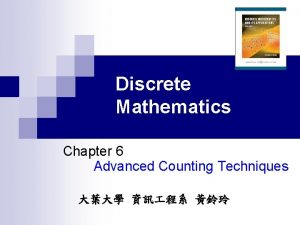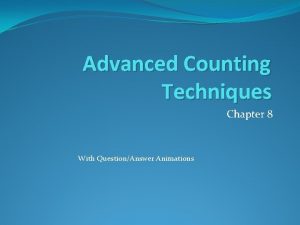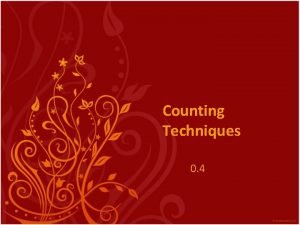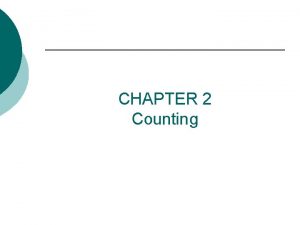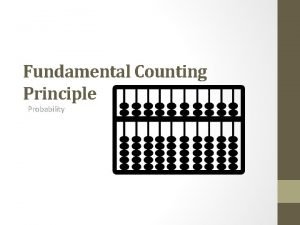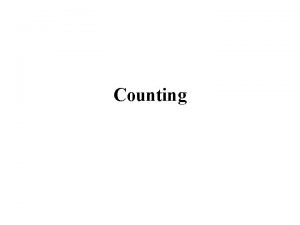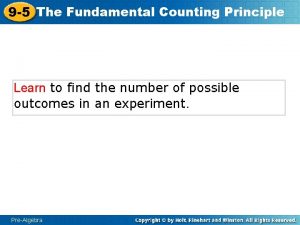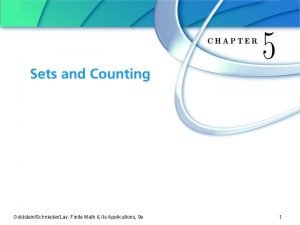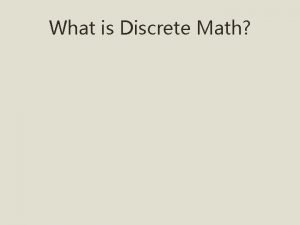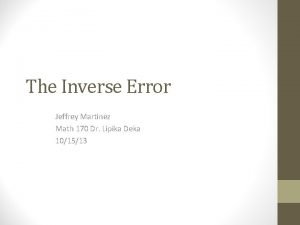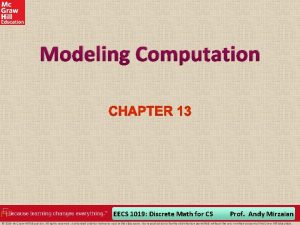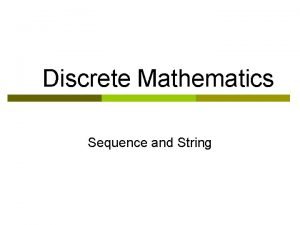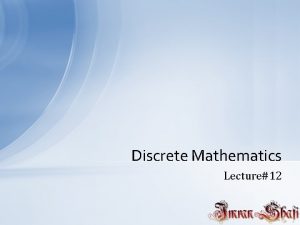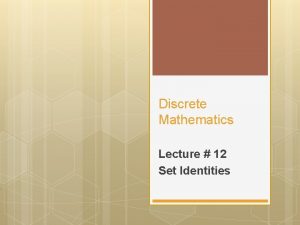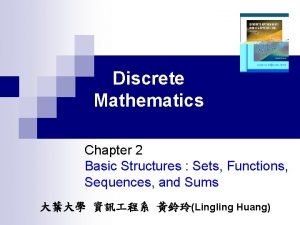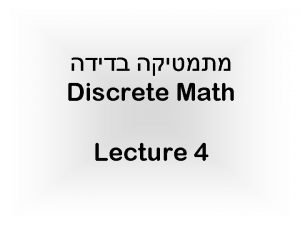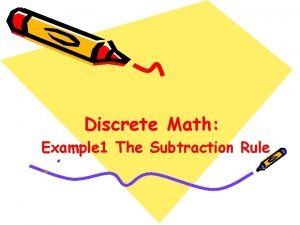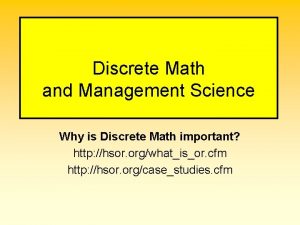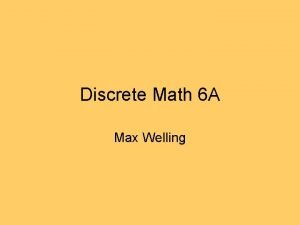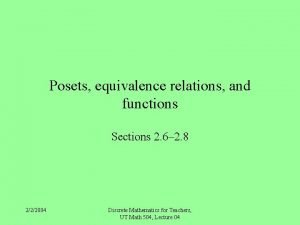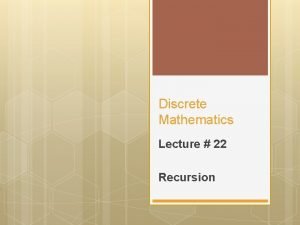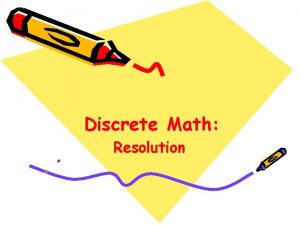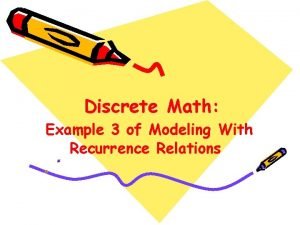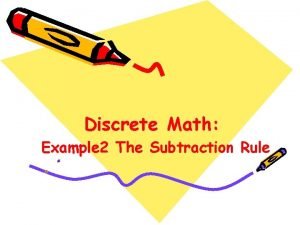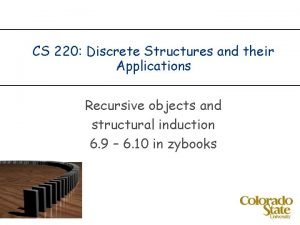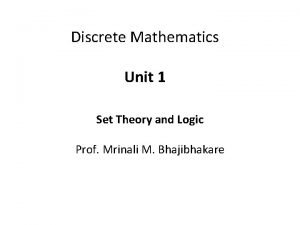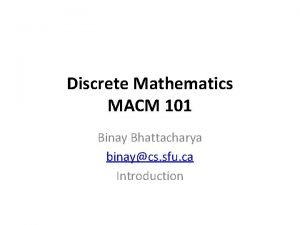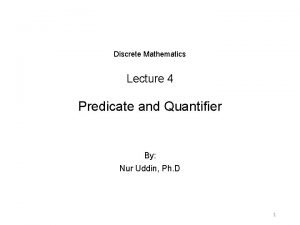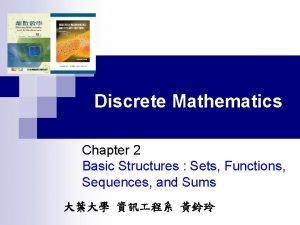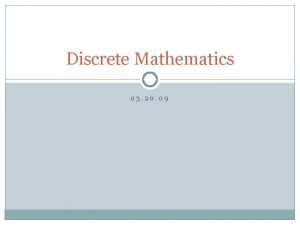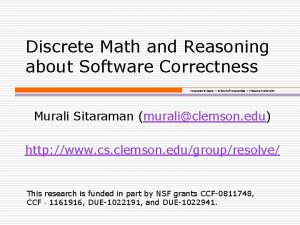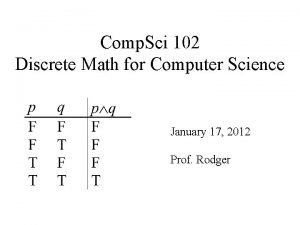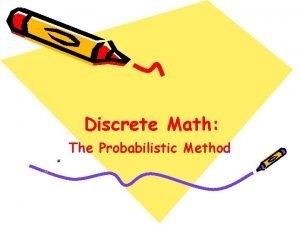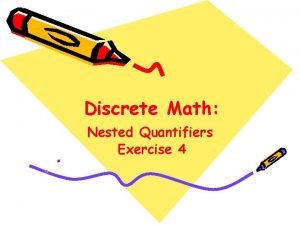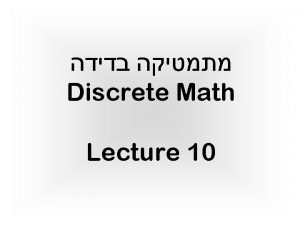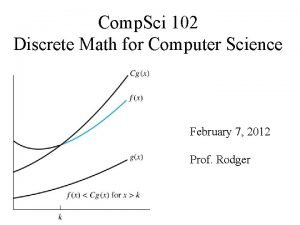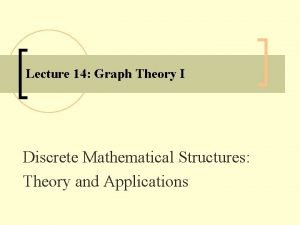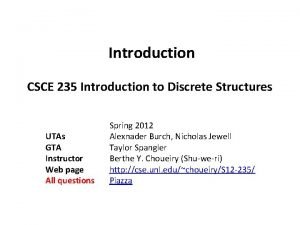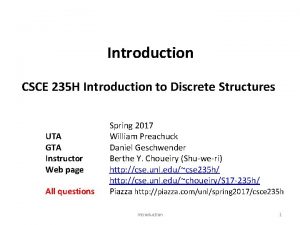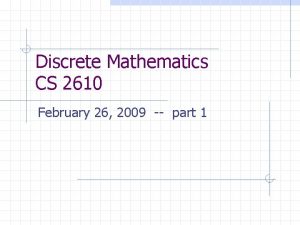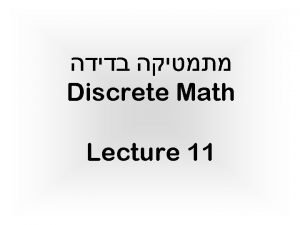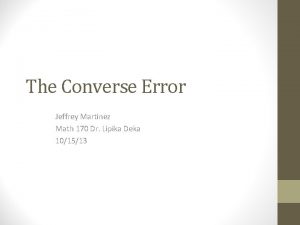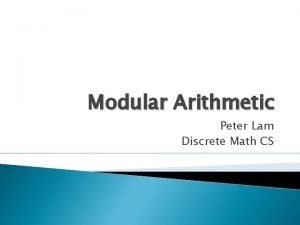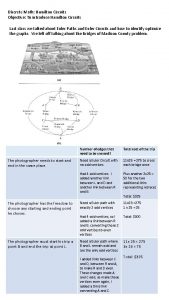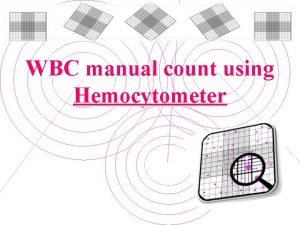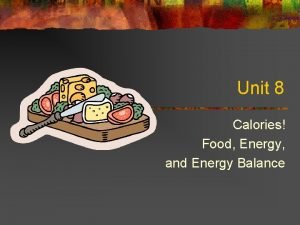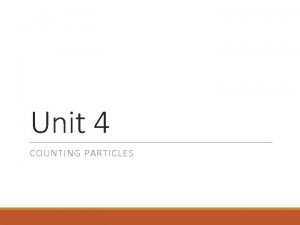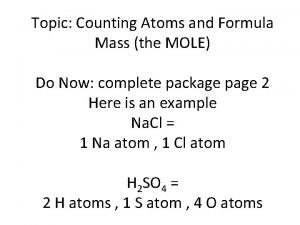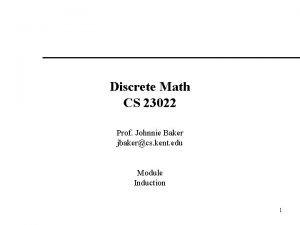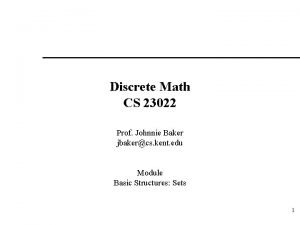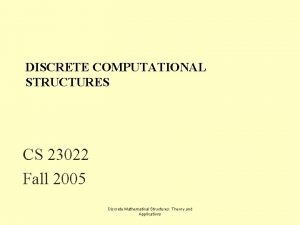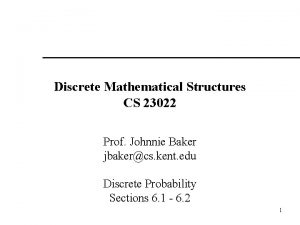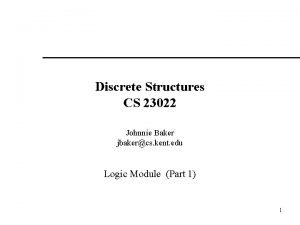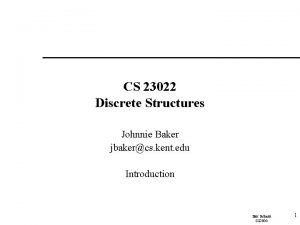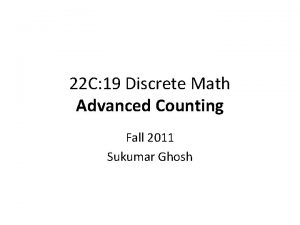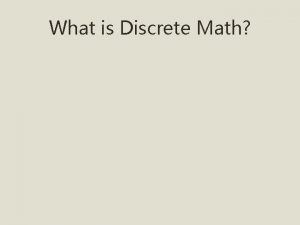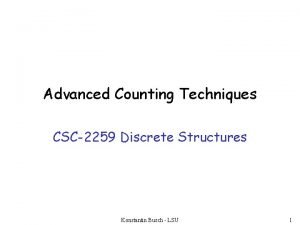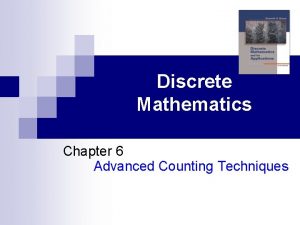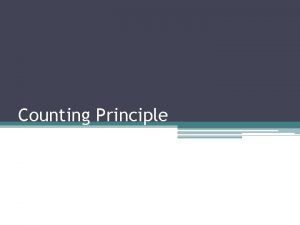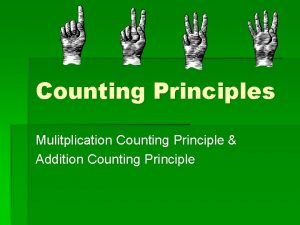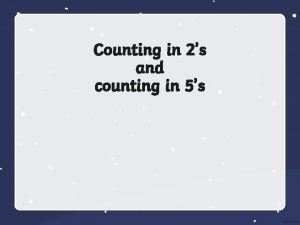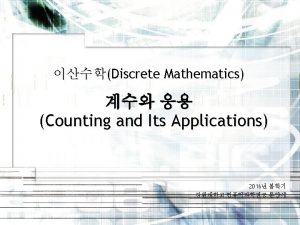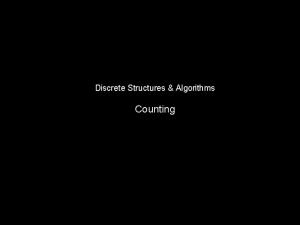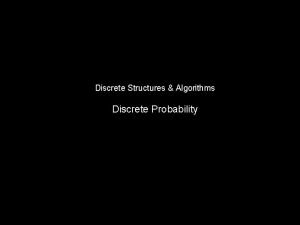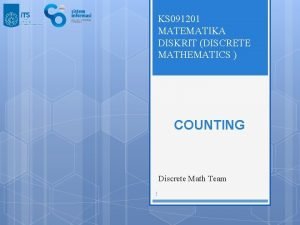Discrete Math CS 23022 Advanced Counting Techniques Prof



































































- Slides: 67

Discrete Math CS 23022 Advanced Counting Techniques Prof. Johnnie Baker jbaker@cs. kent 1

Combinatorics Count the number of ways to put things together into various combinations. e. g. If a password is 6, 7, or 8 characters long; a character is an uppercase letters or a digit, and the password is required to include at least one digit how many passwords can there be? Or, how many graphs are there on N nodes? How many of those are 3 -colorable? Many uses in discrete math (because of all the discrete strucures), including e. g. probability theory (next topic). E. g. , what is the probability that a randomly generated graph is 3 colorable? How can we figure that out? First, two most basic rules: – Sum rule – Product rule

Acknowledgement Most of these slides were either created by Professor Bart Selman at Cornell University or else are modifications of his slides 3

Sum Rule Let us consider two tasks: – m is the number of ways to do task 1 – n is the number of ways to do task 2 – Tasks are independent of each other, i. e. , • Performing task 1 does not accomplish task 2 and vice versa. Sum rule: the number of ways that “either task 1 or task 2 can be done, but not both”, is m + n. Task 1 Generalizes to multiple tasks. . . Task 2

Example A student can choose a computer project from one of three lists. The three lists contain 23, 15, and 19 possible projects respectively. How many possible projects are there to choose from? 23+15+19 Ok… not to worry. things will get more exciting. . . 5

Sum rule example How many strings of 4 decimal digits, have exactly three digits that are 9 s? – The string can have: • • • – – The non-9 as the first digit OR the non-9 as the second digit OR the non-9 as the third digit OR the non-9 as the fourth digit Thus, we use the sum rule For each of those cases, there are 9 possibilities for the non-9 digit (any number other than 9) Thus, the answer is 9+9+9+9 = 36 6

Set Theoretic Version If A is the set of ways to do task 1, and B the set of ways to do task 2, and if A and B are disjoint, then: “the ways to do either task 1 or 2 are A B, and |A B| = |A| + |B|” 7

Product Rule Let us consider two tasks: – m is the number of ways to do task 1 – n is the number of ways to do task 2 – Tasks are independent of each other, i. e. , • Performing task 1 does not accomplish task 2 and vice versa. Product rule: the number of ways that “both tasks 1 and 2 can be done” in mn. Generalizes to multiple tasks. . . task 1 task 2

Product rule example – There are 18 math majors and 325 CS majors – How many ways are there to pick one math major and one CS major? Total is 18 * 325 = 5850 9

Product Rule How many functions are there from set A to set B? B A So, how many Boolean functions on n vars? n 2 2 To define each function we have to make 3 choices, one for each element of A. Each has 4 options (to select an element from B). 4 4 4 How many ways can each choice be made? 43= 64 = |B| |A|

# is called P(n, r) for r-permutations (here P(4, 3) --- “ 3 unique choices out of 4 objects”, order matters) How many one-to-one functions are there from set A to set B? B A Ex: S={1, 2, 3}. Ordered arrangement 3, 1, 2 is called a permutation. There are n! of those (product rule). 3, 2 is a r-permutation (r=2). There are n!/(n-r!) of those. To define each function we have to make 3 choices, one for each element of A. How many ways can each choice be made? 4 3 2 Hmm. What if |A| = 4? 24 = 4! / (4 -3)!

Product rule example How many strings of 4 decimal digits, do not contain the same digit twice? We want to chose a digit, then another that is not the same, then another… • • First digit: 10 possibilities Second digit: 9 possibilities (all but first digit) Third digit: 8 possibilities Fourth digit: 7 possibilities Total = 10*9*8*7 = 5040 How many strings of 4 decimal digits, end with an even digit? First three digits have 10 possibilities Last digit has 5 possibilities Total = 10*10*10*5 = 5000 12

Set Theoretic Version If A is the set of ways to do task 1, and B the set of ways to do task 2, and if A and B are disjoint, then The ways to do both task 1 and 2 can be represented as A B, and |A B|=|A|·|B| 13

More complex counting problems Combining the product rule and the sum rule. Thus we can solve more interesting and complex problems. 14

Count the number of ways to put things together into various combinations. E. g. If a password is 6, 7, or 8 characters long; a character is an uppercase letters or a digit, and the password is required to include at least one digit. How many passwords can there be? Let P – total number of possible passwords Pi – total number of passwords of length i, i = 6, 7, 8 P = P 6 + P 7 + P 8 (sum rule) Pi – computing it directly is tricky (hmm…) “popular” counting trick: let’s calculate all of them, including those with no digits and then subtract the ones with no digits. Pi= 36 i – 26 i P = 366 – 266+ 367 – 267 + 368 – 268 = 2, 684, 483, 063, 360

IP Address Example (Internet Protocol v. 4) An address is a string of 32 bits – it begins with a network id (netid), followed by a host number (hostid), which identifies a computer as a member of a particular network. Main computer addresses are in one of 3 types: – Class A (largest networks): address contains a 0 followed by 7 -bit “netid” ≠ 17, and a 24 bit “hostid” – Class B (medium networks): address contains a 10 followed by a 14 -bit netid and a 16 -bit hostid. – Class C (smallest networks): address contains a 110 has 21 -bit netid an 8 -bit hostid. Netids all 1 s are not allowed. Hostids that are all 0 s or all 1 s are not allowed. How many valid IP addresses are there?

Example Using Both Rules: IP address solution (# addrs) = (# class A) + (# class B) + (# class C) (by sum rule) # class A = (# valid netids)·(# valid hostids) (by product rule) (# valid class A netids) = 27 − 1 = 127. (# valid class A hostids) = 224 − 2 = 16, 777, 214. Continuing in this fashion we find the answer is: 3, 737, 091, 842 (3. 7 billion IP addresses)

Wedding pictures example Consider a wedding picture of 6 people – There are 10 people, including the bride and groom How many possibilities are there if the bride must be in the picture? Product rule: place the bride AND then place the rest of the party First place the bride • She can be in one of 6 positions Next, place the other five people via the product rule • • There are 9 people to choose for the second person, 8 for the third, etc. Total = 9*8*7*6*5 = 15120 Product rule yields 6 * 15120 = 90, 720 possibilities Q. : Are we counting same subsets of folks in different positions? Yes! (note bride is treated “differently”; has to be in; draw diagram) 18

Wedding pictures example Consider a wedding picture of 6 people – There are 10 people, including the bride and groom How many possibilities are there if the bride and groom must both be in the picture Product rule: place the bride/groom AND then place the rest of the party First place the bride and groom • • • She can be in one of 6 positions He can be in one 5 remaining positions Total of 30 possibilities Next, place the other four people via the product rule • • There are 8 people to choose for the third person, 7 for the fourth, etc. Total = 8*7*6*5 = 1680 Product rule yields 30 * 1680 = 50, 400 possibilities 19

Wedding pictures example Consider a wedding picture of 6 people – There are 10 people, including the bride and groom How many possibilities are there if only one of the bride and groom are in the picture? Sum rule: place only the bride • • Product rule: place the bride AND then place the rest of the party First place the bride l • She can be in one of 6 positions Next, place the other five people via the product rule There are 8 people to choose for the second person, 7 for the third, etc. » We can’t choose the groom! Total = 8*7*6*5*4 = 6720 • l Product rule yields 6 * 6720 = 40, 320 possibilities OR place only the groom • Same possibilities as for bride: 40, 320 (hmm… quickly, how many? ) Sum rule yields 40, 320 + 40, 320 = 80, 640 possibilities 20

Wedding pictures example Consider a wedding picture of 6 people – There are 10 people, including the bride and groom Alternative means to get the answer How many possibilities are there if only one of the bride and groom are in the picture? Total ways to place the bride (with or without groom): 90, 720 • See before. Total ways for both the bride and groom: 50, 400 • See before. Total ways to place ONLY the bride: 90, 720 – 50, 400 = 40, 320 Same number for the groom Total = 40, 320 + 40, 320 = 80, 640 21

The inclusion-exclusion principle (seen briefly when we did sets) When counting the possibilities, we can’t include a given outcome more than once. |A 1 U A 2| = |A 1| + |A 2| - |A 1 ∩ A 2| – E. g. Let A 1 have 5 elements, A 2 have 3 elements, and 1 element be both in A 1 and A 2 – Total in the union is 5+3 -1 = 7, not 8 22

Inclusion-exclusion example How may bit strings of length eight start with 1 or end with 00? Count bit strings that start with 1 – – Rest of bits can be anything: 27 = 128 This is |A 1| Count bit strings that end with 00 – – Rest of bits can be anything: 26 = 64 This is |A 2| Count bit strings that both start with 1 and end with 00 – – Rest of the bits can be anything: 25 = 32 This is |A 1 ∩ A 2| Use formula |A 1 U A 2| = |A 1| + |A 2| - |A 1 ∩ A 2| Total is 128 + 64 – 32 = 160

How many bit strings of length 10 contain either 5 consecutive 0 s or 5 consecutive 1 s? Consider 5 consecutive 0 s first Sum rule: the 5 consecutive 0’s can start at position 1, 2, 3, 4, 5, or 6 – Starting at position 1 • Remaining 5 bits can be anything: 25 = 32 – Starting at position 2 • First bit must be a 1 – Otherwise, we are including possibilities from the previous case! • Remaining bits can be anything: 24 = 16 – Starting at position 3 • Second bit must be a 1 (same reason as above) • First bit and last 3 bits can be anything: 24 = 16 – Starting at positions 4 and 5 and 6 • Same as starting at positions 2 or 3: 16 each – Total = 32 + 16 + 16 = 112 The 5 consecutive 1’s follow the same pattern, and have 112 possibilities There are two cases counted twice (that we thus need to exclude): 0000011111 and 1111100000 Total = 112 + 112 – 2 = 222

Tree diagrams We can use tree diagrams to enumerate the possible choices. Once the tree is laid out, the result is the number of (valid) leaves. 25

Tree diagrams example Use a tree diagram to find the number of bit strings of length four with no three consecutive 0 s

Pigeonhole Principle If k+1 objects are assigned to k places, then at least 1 place must be assigned ≥ 2 objects. Proof: (by contradiction) Suppose none of the k places contains more than one object. Then the total number of objects would be at most k. This is a contradiction, since there QED are k + 1 objects. In terms of the assignment function: If f: A→B and |A|≥|B|+1, then some element of B has ≥ 2 pre-images under f. I. e. , f is not one-to-one.

More pigeons than pigeonholes

Example How many students must be in class to guarantee that at least two students receive the same score on the final exam, if the exam is graded on a scale from 0 to 100 points? 102 So, if a million students take a national test with say 100 questions, many must have the same score (in expectation 10, 000). So, would need at least a million questions to get a chance of a unique score for everyone.

Simple Example It’s dark; you know that in your drawer there are: 12 10+12 10 But you can’t see a thing. How many socks should you get to guarantee a correct pair? What does it have to do with the pigeon hole principle? A. : 3 1 hole per color

There must be at least two people in New York city with exactly the same number of hairs on their heads. Why? Typical head of hair has around 150, 000 hairs. So, it is reasonable to assume that no one has more than 1, 000 hairs on their head (m = 1 million holes). There are more than 1, 000 people in NYC (n is bigger than 1 million objects). If we assign a pigeonhole for each number of hairs on a head, and assign people to the pigeonhole with their number of hairs on it, there must be at least two people with the same number of hairs on their heads. Useful stuff to know…

Generalized Pigeonhole Principle If N≥k+1 objects are assigned to k places, then at least one place must be assigned at least N/k objects. E. g. , there are N = 280 people in a party. There are k = 52 weeks in the year. – Therefore, there must be at least 1 week during which at least 280/52 = 5. 38 = 6 students in the party have a birthday. 32

Proof of G. P. P. By contradiction. Suppose every place has < N/k objects, thus ≤ N/k − 1. Then the total number of objects is at most So, there are less than N objects, which contradicts our assumption of N objects! QED

G. P. P. Example Given: There are 280 people in the party. Without knowing anybody’s birthday, what is the largest value of n for which we can prove that at least n people must have been born in the same month? Answer: 280/12 = 23. 3 = 24 34

A bowl contains 10 red and 10 yellow balls How many balls must be selected to ensure 3 balls of the same color? – One solution: consider the “worst” case • • • – Consider 2 balls of each color You can’t take another ball without hitting 3 Thus, the answer is 5 Via generalized pigeonhole principle • • • How many balls are required if there are 2 colors, and one color must have 3 balls? How many pigeons are required if there are 2 pigeon holes, and one must have 3 pigeons? number of boxes: k = 2 We want N/k = 3 What is the minimum N? N=5

A bowl contains 10 red and 10 yellow balls How many balls must be selected to ensure 3 yellow balls? – Consider the “worst” case • • • Consider 10 red balls and 2 yellow balls You can’t take another ball without hitting 3 yellow balls Thus, the answer is 13

PH principles can be pop up in “all kinds of places”… Consider 5 distinct points (xi, yi) with integer values, where i = 1, 2, 3, 4, 5. Show that the midpoint of at least one pair of these five points also has integer coordinates. Thus, we are looking for the midpoint of a segment from (a, b) to (c, d) – The midpoint is ( (a+c)/2, (b+d)/2 ) Note that the midpoint will be integers if a and c have the same parity: are either both even or both odd – Same for b and d There are four parity possibilities – (even, even), (even, odd), (odd, even), (odd, odd) Since we have 5 points, by the pigeonhole principle, there must be two points that have the same parity possibility – Thus, the midpoint of those two points will have integer coordinates. QED

“The party problem” Dinner party of six: Eithere is a group of 3 who all know each other, or there is a group of 3 who are all strangers. By contradiction. Assume we have a party of six where no three people all know each other Let’s say she knows 3 others. and no three people are all strangers. She either knows or doesn’t know each other person. If any of those 3 know each other, we have a blue , which means 3 people know each other. Contradicts assumption. So they all must be strangers. But then we have three strangers. Contradicts assumption. But there are 5 other people! So, she knows, or doesn’t know, at least 3 others. (GPH) The case where she doesn’t know 3 others is similar. Also, leads to constradiction. So, such a party does not exist! QED Consider one person.

Party problem: Nicer in terms of graphs. Consider the complete graph on N = 6 nodes. Now color each edge either blue (“know each other”) or red (“don’t know each other”). It follows that each coloring will contain a red or a blue triangle, no matter how the graph is colored! Proof handles: 215 = 32, 768 possible edge colorings. A blue or red triangle is always present. Removing “symmetries”: 78 cases remain. Example of a Ramsey theory: hidden structure in graphs!

What about a party of five? No red or blue triangle! So, property does not hold for party of five. Define: Let R(k, t) be the minimal n such that if the edges of the complete graph on n nodes are colored Red and Blue, then there either is a complete subgraph of k nodes with all edges Red or a complete subgraph of t nodes with all edges Blue. R(k, t): N 2 -> N is the Ramsey function. R(k, t) is also called the Ramsey number. What is K(3, 3)? K(3, 3) = 6 Ramsey proved that R(k, t) is well-defined. I. e. , for any values of k and t (>= 2), when the n gets large enough, there will always be a monochromatic Red complete subgraph of size k or a Blue one of size t.

What are the values of R(k, k)? R(2, 2) = 2 R(3, 3) = 6 (shown in 1955) R(4, 4) = 18 (shown in 1955) R(4, 5) = 25 (shown in 1993) R(5, 5) = ? (only recently: 43 <= R(5, 5) <= 49) R(6, 6) = ? ? Problem becomes surprisingly difficult, very quickly! Note: N nodes, 2 O(N 2) colorings. N = 10, gives > ~1030; N=30, gives >~10135 Paul Erdös (most productive contemporary mathematician): "Imagine an alien force, vastly more powerful than us landing on Earth and demanding the value of R(5, 5) or they will destroy our planet. [hmm? ] In that case, we should marshal all our computers and all our mathematicians and attempt to find the value. … But suppose, instead, that they asked for R(6, 6), then we should attempt to destroy the aliens". Hmm. Or hire some computer scientists!. . . (Selman ’ 07)

Aside: Can extend to 3 colorings etc. The only two 3 -colorings of the complete graph on 16 nodes, that has no monochromatic triangles.

Permutations A permutation of a set S of objects is an ordered arrangement of the elements of S where each element appears only once: e. g. , 1 2 3, 2 1 3, 3 1 2 There are n! permutations of n objects. (by product rule) An ordered arrangement of r distinct elements of S is called an rpermutation. The number of r-permutations of a set S with n=|S| elements is P(n, r) = n(n− 1)…(n−r+1) = n! / (n−r)! 43

Permutations In a running race of 12 sprinters, each of the top 5 finishers receives a different medal. How many ways are there to award the 5 medals? 12 a) b) c) d) e) 60 125 12!/7! 512 No clue 11 10 9 8 A. : 12!/7! 44

Permutations Suppose you “have” time to listen to 10 songs on your daily jog around campus. There are 6 A tunes, 8 B tunes, and 3 C tunes to choose from. Finally, suppose you still want 4 A, 4 B, and 2 C tunes, and the order of the groups doesn’t matter, but you get dizzy and fall down if all the songs by any one group aren’t played together. How many playlists are there? P(6, 4) x P(8, 4) x P(3, 2) x 3!

Combinations The number of ways of choosing r elements from S (order does not matter). S={1, 2, 3} e. g. , 1 2 , 1 3, 2 3 The number of r-combinations C(n, r) of a set with n=|S| elements is = P(n, r) / r! Note: we have C(n, r) = C(n, n−r) “n choose r”. Also called a “binomial coefficient”. 46

Combination Example How many distinct 7 -card hands can be drawn from a standard 52 -card deck? – The order of cards in a hand doesn’t matter. Answer C(52, 7) = P(52, 7) / P(7, 7) = 52· 51· 50· 49· 48· 47· 46 / 7· 6· 5· 4· 3· 2· 1 = 52. 17. 10. 7. 2. 47. 23 = 133, 784, 560 47

Permutations In how many ways can 5 distinct Martians and 3 distinct Jovians stand in line, if no two Jovians stand together? Hmm… M 1 M 2 M 3 M 4 5! X P(6, 3) = 5! x C(6, 3) x 3! M 5

Combinatorial proof A combinatorial proof is a proof that uses counting arguments to prove a theorem. – Rather than some other method such as algebraic techniques Most of the questions in this section are phrased as, “find out how many possibilities there are if …” – Instead, we could phrase each question as a theorem: – “Prove there are x possibilities if …” – The same answer could be modified to be a combinatorial proof to theorem 49

Circular seatings How many ways are there to sit 6 people around a circular table, where seatings are considered to be the same if they can be obtained from each other by rotating the table? First, place the first person in the north-most chair – Only one possibility (why can we restrict ourselves to only one specific person in that chair? ) Then place the other 5 people – There are P(5, 5) = 5! = 120 ways to do that any more issues with rotating table? no! By the product rule, we get 1*120 =120 Alternative means to answer this: There are P(6, 6) = 720 ways to seat the 6 people around the table For each seating, there are 6 “rotations” of the seating Thus, the final answer is 720/6 = 120

Horse races How many ways are there for 4 horses to finish if ties are allowed? – Note that order does matter! Solution by cases – No ties • The number of permutations is P(4, 4) = 4! = 24 – Two horses tie • There are C(4, 2) = 6 ways to choose the two horses that tie • There are P(3, 3) = 6 ways for the “groups” to finish – A “group” is either a single horse or the two tying horses • By the product rule, there are 6*6 = 36 possibilities for this case – Two groups of two horses tie • There are C(4, 2) = 6 ways to choose the two winning horses • The other two horses tie for second place – Three horses tie with each other • There are C(4, 3) = 4 ways to choose the two horses that tie • There are P(2, 2) = 2 ways for the “groups” to finish • By the product rule, there are 4*2 = 8 possibilities for this case – All four horses tie • There is only one combination for this – By the sum rule, the total is 24+36+6+8+1 = 75

Binomial Coefficients (a + b)4 = (a + b)(a + b) = a 4 + a 3 b + a 2 b 2 + ab 3 + b 4 Binomial Theorem: Let x and y be variables, and let n be any nonnegative integer. Then 52

What is the coefficient of a 8 b 9 in the expansion of (3 a +2 b)17? What is n? 17 What is j? 9 What is x? 3 a What is y? 2 b

Binomial Coefficients (a + b)2 = a 2 + 2 ab + b 2 (a + b)3 = a 3 + 3 a 2 b + 3 ab 2 + b 3 (a + b)4 = a 4 + 4 a 3 b + 6 a 2 b 2 + 4 ab 3 + b 4 Pascal’s triangle What is coefficient of a 9 b 3 in (a + b)12? A. : 220 A. B. C. D. E. 36 220 15 6 No clue

Binomial Coefficients Powers of 2 Sum each row of Pascal’s Triangle: Suppose you have a set of size n. How many subsets does it have? 2 n How many subsets of size 0 does it have? n. C 0 How many subsets of size 1 does it have? n. C 1 How many subsets of size 2 does it have? n. C 2 Add them up we have the result. QED

Alternative (clever) proof? Look at binomial theorem… x and y are variables; can pick any numbers… hmm… Pick x=1 and y=1 ! QED

T n items S n-1 items a Pascal’s Identity A relationship between the entries in Pascal’s triangle. Suppose T is a set, |T|=n. Let a be an element in T, and let S = T - {a}. So, |S| = n-1. Let’s count the subsets of size j. Note that some of these contain a, and some don’t. How many contain a? How many don’t? 57

Vandermonde’s Identity Let m, n, and r be nonnegative integers with r not exceeding either m or n. Then Why? A m items B n items To choose r items, take some [(rj)] from A and some [j] from B. All possible ways of doing this gives the result. (note: items should all be distinct. ) 58

Another combinatorial identity Follows directly from the Vandermonde’s identity with m = r = n: for the last step we used:

And another Proof. See thm. 4, section 5. 4

Combinations with repetition There are C(n+r-1, r), r-sized combinations from a set of n elements when repetition is allowed. Proof. See thm. 2, section 5. 5. Example: How many solutions are there to the equation When the variables are nonnegative integers? 11 locations for bars. Pick 3 allowing repetitions. C(13, 3)

Co Counting paths mb in ato ria l c upper left corner of an n x m grid and A turtle begins at the ou nti right corner. meanders to the lower ng req n = 6 uir es pr ac m=4 Need m steps down. e. a n+1 positions M or b to go down. eo nch wk ! tic How many routes could she take if she only moves right and down? Hmm…


Permutations with indistinguishable objects How many different strings can be made from the letters in the word rat? 6 How many different strings can be made from the letters in the word egg? 3 64

Permutations with indistinguishable objects How many different strings can be made from the letters in the phrase nano-nano? Key thoughts: 8 positions, 3 kinds of letters to place. In how many ways can we place the ns? 8 C 4, now 4 spots are left In how many ways can we place the as? 4 C 2, now 2 spots are left In how many ways can we place the os? 2 C 2, now 0 spots are left 65

Permutations with indistinguishable objects How many distinct permutations are there of the letters in the word APALACHICOLA? How many if the two Ls must appear together? How many if the first letter must be an A? 66

A little practice In how many ways can 11 identical computer science books and 8 identical psychology books be distributed among 5 students? Hint: forget about the psychology books for the moment. Hint: how can you combine your soln for the CS books with your soln for the Psych books? 67
 Discrete probability and advanced counting techniques
Discrete probability and advanced counting techniques Counting techniques in discrete mathematics
Counting techniques in discrete mathematics Advanced counting techniques
Advanced counting techniques Basics of counting in discrete mathematics
Basics of counting in discrete mathematics Counting techniques probability
Counting techniques probability Counting problems examples
Counting problems examples Using tree diagram
Using tree diagram Counting techniques examples
Counting techniques examples Fundamental counting principle examples
Fundamental counting principle examples Venn diagram finite math
Venn diagram finite math What is discrete math
What is discrete math Inverse error example
Inverse error example Eecs 1019
Eecs 1019 What are ps and qs
What are ps and qs Discrete math problems
Discrete math problems Discrete math propositional logic
Discrete math propositional logic String in maths
String in maths Relation discrete math
Relation discrete math Set identities exercises
Set identities exercises Floor and ceiling discrete math
Floor and ceiling discrete math Pqr truth table
Pqr truth table Total function definition
Total function definition Product rule discrete math
Product rule discrete math What is discrete math
What is discrete math Discrete math cartesian product
Discrete math cartesian product Susanna s epp
Susanna s epp Poset discrete math
Poset discrete math Counterexample discrete math
Counterexample discrete math Recursion discrete math
Recursion discrete math Resolution example
Resolution example Recurrence discrete math
Recurrence discrete math A computer company receives 350 applications
A computer company receives 350 applications Knights and knaves discrete math
Knights and knaves discrete math Structural induction discrete math
Structural induction discrete math Discrete mathematics
Discrete mathematics Macm
Macm Predicate discrete math
Predicate discrete math Sequence discrete math
Sequence discrete math Division algorithm in discrete mathematics
Division algorithm in discrete mathematics Vcs
Vcs Discrete mathematics
Discrete mathematics Discrete math tutor
Discrete math tutor Let t(x y) mean that student x likes dish y
Let t(x y) mean that student x likes dish y Binary relation in discrete mathematics
Binary relation in discrete mathematics Big-o notation discrete math
Big-o notation discrete math Discrete math
Discrete math Discrete math definition
Discrete math definition Discrete structures
Discrete structures Traveling salesman problem
Traveling salesman problem Inverse relation example
Inverse relation example Big o notation discrete math
Big o notation discrete math Discrete math
Discrete math Converse error
Converse error Modular arithmetic discrete math
Modular arithmetic discrete math Discrete math circuits
Discrete math circuits Ponce prof de math
Ponce prof de math Sketch chapter 7
Sketch chapter 7 Advanced evasion techniques
Advanced evasion techniques Advanced interviewing techniques
Advanced interviewing techniques Point processing techniques
Point processing techniques Advanced data visualization techniques
Advanced data visualization techniques Advanced construction methods
Advanced construction methods Fonctions et solutions techniques
Fonctions et solutions techniques Hit the button
Hit the button How to count wbc in hemocytometer
How to count wbc in hemocytometer Biobeyond unit 8 nutrition lab counting calories
Biobeyond unit 8 nutrition lab counting calories Counting by weighing
Counting by weighing Counting atoms in one gram
Counting atoms in one gram

